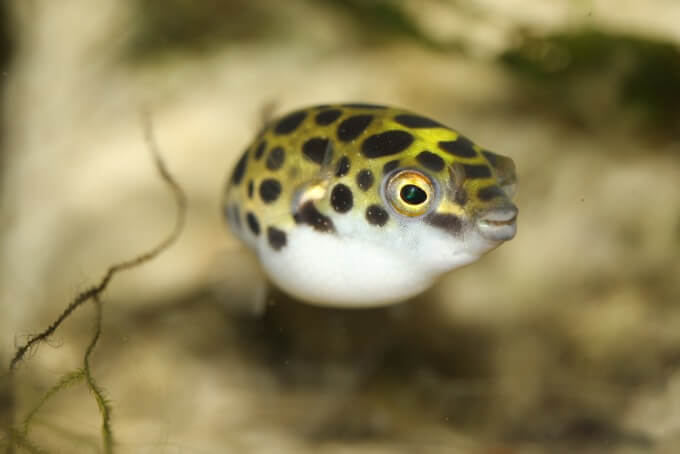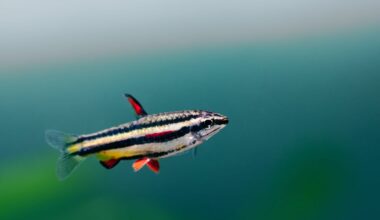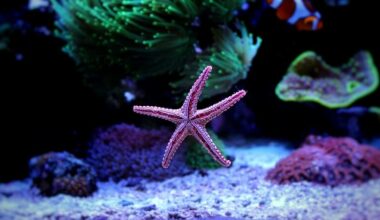Snail-eating fish are one of the best ways to get rid of snails in your aquarium. Instead of you going through the agonizing process of removing them yourself, these fish do all the heavy lifting!
What’s neat is that these fish are more than just snail killers. Many of them are quite beautiful and provide a number of additional benefits too!
This guide will go through each of the best fish to help you deal with a snail problem in your tank. We recommend a lot of these fish regardless, so their ability to eat snails is really just the icing on the cake!
Why An Out of Control Snail Population Is A Problem
Newer aquarists might be pleased by a hitchhiker snail that makes its way into an established environment. However, seasoned hobbyists know that one stray snail is only the start of a maintenance nightmare!
Snails multiply at a rapid pace, and most species do not need a mate to reproduce. They will lay and fertilize up to 50 eggs on their own, leading to a budding population.
Once that second generation of snails starts reproducing, they can quickly take over a tank.
The issue with snail overpopulation comes down to the biological load on your tank. It doesn’t matter how big or small your aquarium is. The more living creatures you add to is, the harder it’s going to be to maintain water conditions.
Sure, many snails will eat leftover food, algae, and decaying plant matter. But they’ll also produce a ton of waste.
It might not seem like much, but when you’re dealing with an overrun tank, the effects of that waste can wreak havoc on the ecosystem.
Filtration systems can only handle so much. Before you know it, it’ll be impossible to keep ammonia and nitrate levels down, which will cause serious harm to your other fish.
The Importance Of Picking The Right Fish
Several fish species have a healthy appetite for snails. They’ll hunt down these pests and keep the snail population at reasonable levels.
That said, you can’t just pick any fish species and expect to see good results. Ultimately, the goal here is to save your tank and improve the living conditions for your existing fish.
To do that, you need to consider how the snail-eating fish will fit in. They must be compatible with other tank mates and flourish with existing water conditions in the aquarium.
With those two factors in mind, here are some fish that eat snails for you to consider:
1. Yoyo Loach
Yoyo Loaches are beautiful bottom-dwelling fish that enjoy digging in the sand. While peaceful to other fish species, Yoyo Loaches will search for snails to consume.

Thanks to their penchant for digging, they’re quite effective at their job! These fish will use their barbels to feel around the substrate. Once they find a snail, they can suck it right out of the shell!
These fish have hard teeth in their throats, so you might even hear a clicking noise as they chew!
Yoyo Loaches are a peaceful yet lively addition to the tank. They get along with most species and are hardy enough to stay comfortable in most standard water conditions.
- Size: 2.5 inches
- Difficulty: Intermediate
- Minimum Tank Size: 40 gallons
2. Striped Raphael Catfish
The Striped Raphael Catfish is a gorgeous fish species that can live for well over a decade in the right conditions. Like other catfish, they are bottom-dwelling fish that utilize barbels to search for food.

The body of the fish is torpedo-shaped and features dramatic horizontal stripes, hence its name. These fish are also heavily protected thanks to their curved spines and sharp fin rays.
Native to South America, Striped Raphael Catfish are used to eating invertebrates. In the wild, they often consume shrimp, snails, and insects.
In captivity, the fish will eat much of the same thing, making them a great choice for getting rid of snails in your aquarium.
- Size: 6 inches
- Difficulty: Beginner
- Minimum Tank Size: 50 gallons
3. Clown Loach
Here’s a colorful fish species that you can always rely on when it comes to getting rid of snails. The Clown Loach has quite the reputation as a snail-eating fish (and for good reason).

You might see them patrolling the waters before quickly digging under the substrate. This makes them highly efficient at getting rid of snails that like to burrow and hide.
When they’re not searching for snail snacks, Clown Loaches are peaceful community fish. They get along with other non-aggressive fish species and do very well in large community tanks.
They also adapt well to basic freshwater conditions. The species prefers temperatures around 78 degrees, neutral pH balance, and moderate water hardness.
- Size: 12 inches
- Difficulty: Intermediate
- Minimum Tank Size: 100 to 150 gallons
4. Gourami
Naturally found throughout Southeast Asia, Gouramis are a very popular species in the aquarium trade. Covered in shades of blue, silver, and even red, they can add a lot of life to an underwater environment.

Gouramis belong to a special class of fish. They’re labyrinth fish, which means that they have a lung-like organ that lets them breathe air. As a result, these fish are very hardy and capable of living in low-oxygen environments.
For the most part, Gouramis are quite peaceful and only get aggressive in overcrowded tanks. However, you’ll also see them get aggressive towards snails!
These fish are powerful enough to rip snails right from their shells as a snack. There are plenty of species to choose from, but we recommend giving Dwarf Gourami a shot.
- Size: Varies
- Difficulty: Beginner-Intermediate
- Minimum Tank Size: Varies
5. Dwarf Chain Loach
The Dwarf Chain Loach is an interesting fish with a distinct look. Endemic to Cambodia, Laos, and Thailand, these are shoaling fish that typically occupy the bottom of the water column.
Chain Loaches get their name from their appearance. The top half of the body features a thick band of black. However, spots of silver run along the entire band, giving it the appearance of a metal chain!
Like other loaches, this species has delicate barbels that they use to hunt for food. You can often find them in large groups searching for snails to eat and other snacks in the substrate.
- Size: 2 inches
- Difficulty: Intermediate
- Minimum Tank Size: 30 gallons
6. Bala Shark
Despite what their name would leave you to believe, Bala Sharks are not aggressive creatures. They’re relatively peaceful. Beyond their body shape and triangular dorsal fin, these fish don’t share any other characteristics with predatory sharks.

They will, however, eat smaller creatures they find in the tank. This includes snails, small fish, and shrimp.
These fish have very healthy appetites. They require food three times a day. Even still, you can often find Bala Sharks eating snails whenever they get the opportunity!
Bala Sharks are active and social fish. They do best in groups and require a lot of space to swim and explore.
- Size: 12 inches
- Difficulty: Beginner-Intermediate
- Minimum Tank Size: 120 to 150 gallons
7. Zebra Loach
Zebra Loaches are another fish species that does best in a group. While not technically shoaling fish, Zebra Loaches are known to get aggressive when there are less than five in the same tank.

Interestingly enough, most Zebra Loaches prefer to be alone. You can find them searching for food at the bottom of the tank. Sometimes, they’ll stay still for hours on end. Other times, you can see them actively exploring!
This species requires a stable environment to stay healthy. They do best in temperatures between 73 and 79 degrees Fahrenheit, slightly alkali water, and moderate hardness. Good oxygenation is also a must.
- Size: 3 to 4 inches
- Difficulty: Beginner
- Minimum Tank Size: 30 gallons
8. Cory Catfish
The ever-popular Cory Catfish has a slightly different attitude towards snails. They’re not interested in some species, since as they tend to avoid larger snails.

Most Cory Catfish will focus their attention on smaller snails (and their eggs). They do a fantastic job of getting rid of snails in your aquarium that hide in the substrate.
They use their barbels to sniff out snails as they scavenge. Then, they’ll dig into the substrate to suck them out. These fish are very powerful diggers, so don’t be surprised if you see them with their entire head in the sand!
Overall Cory Catfish are peaceful community fish. They spend most of their time scouring the bottom of the tank for food, leaving other fish to occupy other parts of the water column.
- Size: 1 to 4 inches
- Difficulty: Beginner
- Minimum Tank Size: 20 to 30 gallons
9. Goldfish
Believe it or not, Goldfish are one of the most prolific predators for snails! Nearly every type of Goldfish species, from common to fancy, will seek out snails to eat.

They are more than willing to eat any snail that they can fit in their mouth. However, they will often avoid larger adult snails. To remove those, you’ll have to rely on another species.
Adding Goldfish to your tank can be tough. These fish require cooler water that’s lower on the hardness scale. As a result, you can’t add them to warmer tanks with tropical fish.
- Size: Varies
- Difficulty: Beginner-Intermediate
- Minimum Tank Size: Varies
10. Green Spotted Puffer
Green Spotted Puffers are adorable fish that have the ability to get larger in size for defense purposes. While that’s certainly interesting to see, you never want to get your fish to that point. Puffing up means that they’re experiencing extreme stress.

Snails are an important part of a Green Spotted Puffer’s diet. Not only do they enjoy the taste, but they will chew on the shells. The shells help to wear down their beak-like teeth, which would otherwise continue growing until they become a handicap.
The only caveat with keeping Green Spotted Puffers is that they need brackish water. Their environment must have a specific gravity between 1.005 and 1.20.
- Size: 6 inches
- Difficulty: Intermediate
- Minimum Tank Size: 30 gallons
11. Betta Fish
Betta Fish are known for their beauty and grace. However, these fish can attack and eat snails just the same.

Like Gouramis, Bettas are labyrinth fish with the ability to breathe water. While they do best in well-oxygenated tanks, they can survive in shallow waters, too.
If you’re thinking about adding a Betta Fish to your community tank, you must exercise extreme caution. These are highly aggressive fish that will attack any species that catches their eye.
Most Betta owners choose to keep these fish by themselves. However, you can add other tank mates if you have a large enough environment.
- Size: 3 inches
- Difficulty: Beginner
- Minimum Tank Size: 5 to 10 gallons
12. Assassin Snail
Here’s a creature you probably didn’t expect to see on this list! Assassin Snails one of the best invertebrates to have in a tank that’s overrun by snails.

As their name would suggest, these freshwater snails will actually eat other snails. They’re not picky. Assassin Snails eat any snail species that they trump in terms of size.
Assassin Snails can be very sneaky about their predatory nature, too. You can sometimes see them hiding out in the sand as they wait for a snail to come by.
If you’re worried about Assassin Snails overrunning your tank, you can rest easy. This is a snail species that need to have a mate in order to reproduce.
- Size: 1 inch
- Difficulty: Beginner
- Minimum Tank Size: 10 gallons
Take Your Pick
Now that you know how to get rid of snails in your aquarium with snail-eating fish, it’s time for you to make your choice.
With so many great options it can be hard to decide. Thankfully, you can’t really go wrong!
Simply look for the species that fit your tank conditions and go from there. If you’re having some trouble deciding you can always ask us to weigh in as well.

